Analyzing and reducing grazing occultation which has been observed by “Kagoshima Team”.
Kazuhisa Miyashita
Nov.26 2006
Introduction
The slow brightness change is often observed at grazing events. It is caused by diffracton effect and lunar movement. Shadow of Lunar's edge is indistinctly and it has gradation, because light is diffracted at lunar's limb. In grazing event, shadow of lunar limb has large angle between its normal line and its traveling direction.(I called this “contact edge angle(CE)” in this report.) In such event, the observation site moves diagonally in gradiation on the edge of the shadow. Then the graph of luminous change of phenomenon will be stretched in time it is given by formula ( 1/cos[CE] ). It means that measurement of luminous change will give not only the time of geometrical centre of event but also contact edge angle. And it is expected to calculate the incline of lunar limb.
It was described that the excellent results ware given at the observation of Delta Gem. etc. using video recorded, in previous report. In this paper, I will report that an obvious result is obtained from the observation (grazing XZ5382 on 2006/04/02 observed by Kagoshima Team) which has condition difficult to measure using compared object.
Observation
This event observed by Kagoshima Team*1 using video recorded. The video tape was analyzed by Hayamizu(Table 1) and reduced by Soma(Fig.1). The observation and analysis of this event have several interesting features as following.
i) XZ5382 is double star contain 8.3 mag and 8.3 mag(predicted by
OCCULT ver.3.6).
ii) Several observation was obstructed by clouds. And it caused
analizing difficulty.
It is thought that these features influence for measure luminous changes from video. Double star will form the light curve like a step and clouds make the target star to faint. Hayamizu descrimed in his report that it is necessary to note these features at analizing.
Time was kept by GHS clock1). And time was recorded into video signal by TIVi in most of observation. The recorded time signal has 1/100 second accuracy. In one of observation, time signal was recorded as 1PPS sound signal.
Measurement
Limovie*2 has been used for analyzing this event. And light curves are obtained from video tape. To get highly S/N, object aperture was set as small as it content the star profile and background aperture was set to larger.2)
Analysis
Several tapes in these observations has problem that the object star was decreased its intensity influenced by clouds. In addition to this, in the case impossible to set polar axis of mount, observers should always control the direction of telescope so that a target star should not go outside of screen. Result of this, the objects in the video's screen do the movement not anticipated as the round trip, and beginning the sudden movement, etc. Limovie has a star tracking function, but the function is not abele to following such a large movement. The function called “1frame measure” was provided to analyze these cases. The position of the measurement region can be set at each frame.
To solve the problem absorption of light by cloud, the measurement value of object star was corrected by comparison with measurement of a sunlit point on the moon fase. The result was shown as Fig.2-5. It looks well corrected in this method. And in this analysis, the movement of telescope was obtained and it was refered to measure the object star.
Calucrate the event's time and lunar limb's incline
The version 0.9.25 of Limovie has a function to compare the observation with simulation about light diffraction curve automatically. The values of light change is given by the equation as followings3)4)
I0 is the intensity of brightnes of target star.
t is time.
I(t) is intensity change of the star at the event.
![]() (1)
(1)
C(ω), S(ω) is fresnel integration given as:
![]() (2)
(2)
 (3)
(3)
ω is fresnel number given as:
![]() (4)
(4)
λ is wave length of light.
D is distance of lunar.
V is motion velocity of shadow of lunar limb.
And considered CE then equation is given :
![]() (5)
(5)
Hence, It could be obtain not only the inclination of the lunar limb but also the accurate time of phenomenon, if it can measure with a plural frame. Limovie's diffraction fitting function which based of this principle repeat the fitting process about time and angle until the sum of mean squares become its minimum. The result was shown as Fig.6. The data of observation is well fitting with the simulation at the highly S/N videotape(Fig.6,Fig.7). Additionally, at the low S/N, it is thought that the change of brightnes of light is fitted with simulation comparatively well. Among these lightcurves, Several cases that have the shape of curve which has been effected by double star's occultation was found.
The result of this analysis shown as Table.2. The time of event was calcurated to 1 milli second accurate. It should note that it was not considered with the error margin. However it is thought that it can be estimated event time by this method more accurately than other mothod such as confirmation by watching the chart.
The lunar profile obtained from these analysis is shown Fig.8. It is thought that the appearance of up and down and the inclination of lunar limb is shown well, though It could cross check at few points.
Conclusion
Even if the decrease of object star occurred by thin clouds, luminous value can be estimated based on intensity of light such as sunlit point. Moreover, there is a possibility of the masurement by accuracy that exceeds the restriction of frame about the phenomenon time. Limovie enabled these processing to be done automatically by an easy operation.
In this observation of the Kagoshima team, the inclination obtained from diffraction fitting and geographical features obtained from the phenomenon time is almost corresponding.
I want to expect that this method is used for a lot of grazings in the future.
*1 Compased of the members of Kagoshima Astro Photo Club and Sendai Space Hall.
Toshihisa Maeda, Ikurou Kumomoto, Kazuhisa Saeki, Tsutomu Hayamizu
Hidemi Nakahama, Atsushi Kawakita, Tomohiko Yamada
*2 LIght Measurement tool for Occultation observation using VIdeo rEcorded.
Provided by Kazuhisa Miyashita
1) Hayamizu et.al. GHS clock the high accuracy timekeeper for occultation observation.
Monthly Journal, Astronomical Society of Japan, 93 , 720-727 (2000)
2) Photometry using Limovie : Miyashita et.al. (2006, NAOJ Report)
3) Max Born and Emil Wolf : Principles of Optic : Electromagnetic Theory of Propagation, Interference and Diffraction of Light(7'th edition) (2002) Univetsity of Cambridge.
4) Soumen Mondal : High angular resolution studies of late-type stars by lunar occultation in near-infrared. A Thesis submitted to Gujarat University.(2004)
Table 1 The event time obtained from video tape. (Reduced by Hayamizu.)
------------------------------------------------------------------
No. Observer Date Star Base Time Memo
Ph Timer Event's Time Error Memo
------------------------------------------------------------------
(1) Maeda & Nakahama Apr02 SAO76472 09h58m UT Obs. start
Star
Looks clear. Seeing is a little poor. With Earth Shine.
(2) DD
GPS 10h01m07.16s +/-1Fr disappear
(3) RD GPS 10h01m10.99s +/-1Fr
A
little shine. It has the possibility that it's double star.
(4) RD
GPS 10h01m11.22s +/-1Fr
Slowly luminous change increase to formal
brightness.
(5) DD GPS 10h01m14.34s +/-1Fr disappear
(6) RD GPS
10h01m47.22s +/-1Fr appear
(7)
DD GPS 10h02m02.32s +/-1Fr decreas start
(8) DD GPS 10h02m02.39s
+/-1Fr disappear
(9) RD GPS 10h02m02.96s +/-1Fr
A little shine.
It has the possibility that it's double star.
(10) RD GPS
10h02m03.36s +/-2Fr
Slowly luminous change increase to formal
brightness.
(11) DD GPS 10h02m05.41s +/-1Fr disappear
(12) RD
GPS 10h02m06.95s +/-1Fr appear
(13) DD GPS 10h02m11.95s +/-1Fr
disappear
(14) RD GPS 10h02m12.59s +/-1Fr appear
(15) 10h08m UT Observation End ------------------------------------------------------------------
Time
was kept by GHS clock & TIVi(VTI).
WGS84 130°34'32.95"E
31°17'49.47"N 61m H
------------------------------------------------------------------
------------------------------------------------------------------
No. Observer Date Star Base Time Memo
Ph Timer Event's Time Error Memo
------------------------------------------------------------------
(1) Kazuhisa Saeki Apr02 SAO76472 09h58m UT Obs. Start
Star
Looks clear. Seeing is a little poor. With Earth Shine.
(2) DD
GPS 10h01m00.600s +/-1Fr disappear
(3) RD GPS 10h01m50.367s +/-1Fr appear
Thin clouds move accros before the moon.
(4) DD GPS 10h01m54.433s +/-0.5s
This result is uncertainly because influence of clouds.
Reliability : 2
(5)
RD GPS 10h01m58.467s +/-0.3s
This result is uncertainly because
influence of clouds.
Reliability : 2
(6)
DD GPS 10h01m59.967s +/-2Fr
This result is uncertainly because
influence of clouds.
(7)
RD GPS 10h02m13.600s +/-0.5s
This result is uncertainly because
influence of clouds.
Reliability : 2
(8)
DD GPS 10h02m15.700s +/-2s
This result is uncertainly because
influence of clouds.
Reliability : 3
(9)
RD GPS 10h02m17.067s +/-2Fr
This result is uncertainly because
influence of clouds.
(10)
10h06m UT Observation End
Time was kept by GHS clock (on sound
track).
WGS84 130°34'27.06"E 31°17'42.99"N 70m
H
------------------------------------------------------------------
------------------------------------------------------------------
No. Observer Date Star Base Time Memo
Ph Timer Event's Time Error Memo
------------------------------------------------------------------
(1)
Kumamoto & Kawakita Apr02 SAO76472 09h58m UT Obs. Start
Star
Looks clear. Seeing is a little poor. With Earth Shine.
(2) DD
GPS 10h00m25.29s +/-1Fr disappear
(3)
RD GPS 10h00m25.72s +/-1Fr
A little shine. It has the possibility
that it's double star.
(4) RD GPS 10h00m25.86s +/-1Fr
Slowly
luminous change increase to formal brightness.
(5) DD GPS
10h00m38.23s +/-1Fr disappear
Thin clouds move accros before the
moon.
(6)
RD GPS 10h00m42.08s +/-1Fr appear
(7) DD GPS 10h00m42.92s +/-1Fr
disappear
(8) 10h01m41s obs. Interrupt
influence
of cloud
(9) 10h01m59s obs. re-start
(10)
RD GPS 10h02m19.15s +/-2Fr appear
Thin clouds move accros before
the moon.
(11)
DD GPS 10h02m19.35s +/-2Fr disappear
(12) RD GPS 10h02m20.05s
+/-2Fr appear
Thin clouds move accros before the moon.
(13)
10h05m50s Observation End
Time was kept by GHS clock &
TIVi(VTI).
WGS84 130°34'20.53"E 31°17'35.12"N
81m
H
------------------------------------------------------------------
------------------------------------------------------------------
No. Observer Date Star Base Time Memo
Ph Timer Event's Time Error Memo
------------------------------------------------------------------
(1) Hayamizu & Yamada Apr02 SAO76472 09h56m30s UT Obs.Start
Star
Looks clear. With Earth Shine.
(2) DD GPS 09h59m53.52s +/-1Fr
disappear
(3) RD GPS 10h02m24.81s +/-1Fr appear
(4) DD GPS
10h02m27.01s +/-1Frdecrease start
(5) DD GPS 10h02m27.08s +/-1Fr
disappear
(6) RD GPS 10h02m31.18s +/-1Fr
A little shine. It has
the possibility that it's double star.
(7) RD GPS 10h02m31.35s
+/-2Fr
Slowly luminous change increase to formal brightness.
(
8) 10h05m30s Observation End
Time was kept by GHS clock &
TIVi(VTI).
WGS84 130°34'10.10"E 31°17'23.59"N
110m
H
------------------------------------------------------------------
Table 2 Event ime and incline of lunar limb obtained by diffraction fitting method
with reduction of occultation timming (by Mitsuru Soma)
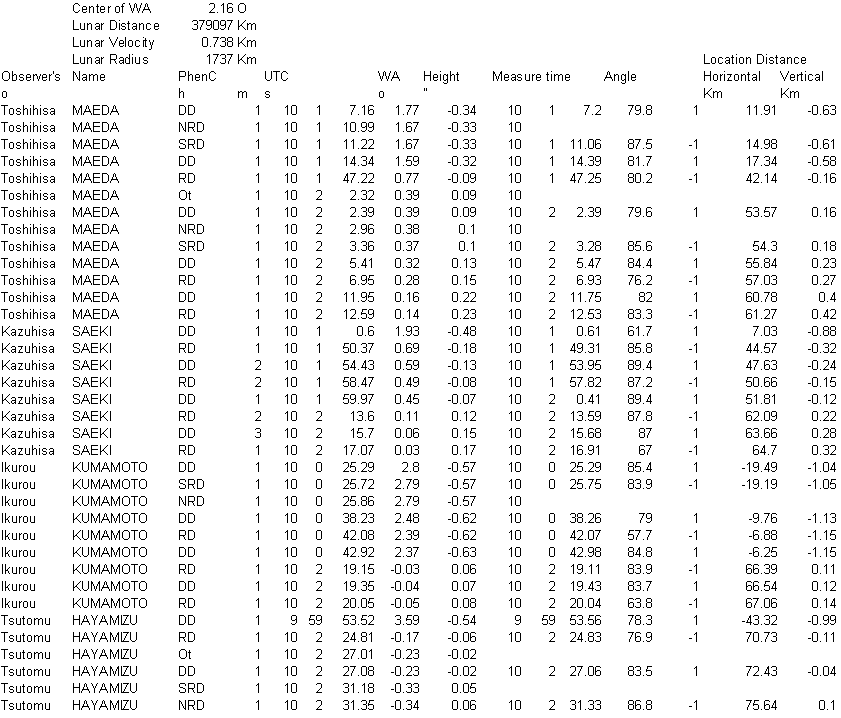
Fig.1 The lunar profile obtained by observation of occultation timming.
|
|
|
|
To estimate the influence by thin cloud, the luminous change of sunlit point on the moon was measured. Drift Mode(non drift scan), Star Tracking Radius=12, Threshold=95 Meteor/Lunar Limb mode, Gap=9 Aperture Radius=5, Background Inner=9, Outer=25 |
Relative motion of telescope was obtained by measurement of sunlit point on lunar limb. Telescope motion had changed at 740 frame. Therefore, the passed point of Drift Scan mode should be set at 740 frame. |
Fig.2 Correction of influenced cloud by compare with brightness of sunlit point.
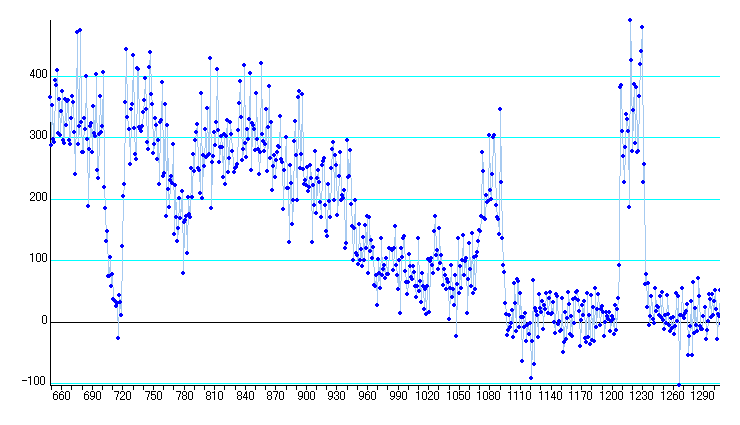
Light curve influenced by thin cloud
Observed by kumamoto during 650 to 1300 Frame.
The slowly decrease of brightness may be influence of cloud.
Star Tracking Radius = 5, Threshold=90, Drift Scan Mode, Passed Point 743-1078
Aperture Radius=5, Background Inner=9, Outer=25
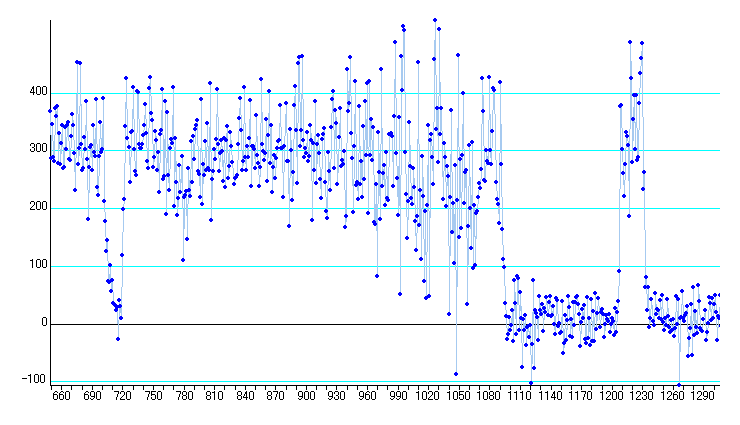
Corrected data, by compared with sunlit place
The measurement value was corrected by compared with brightness change of sunlit place.
As a result of processing, the luminous change became clear.
Fig.3 The effect of the correction by compare with sunlit point as standard object

Observed by Kazuhisa Saeki
It is thought that the light curve, which is shaped like blades of saw, show the effect of successive pass of cloud.
The light curve like this appeared at the event of phemu and occultation by Saturn's ring.
It suggest that when a slight brightness change is measured, we should take account to the absorption of little light by the cloud and the haze.
Fig 4. The change of light absorption by cloud.

Measurement value of the occultation event observed by Saeki
It looks difficult to decide the event time because there are many waves which has middle wave length similar to light curve of phenomenon .
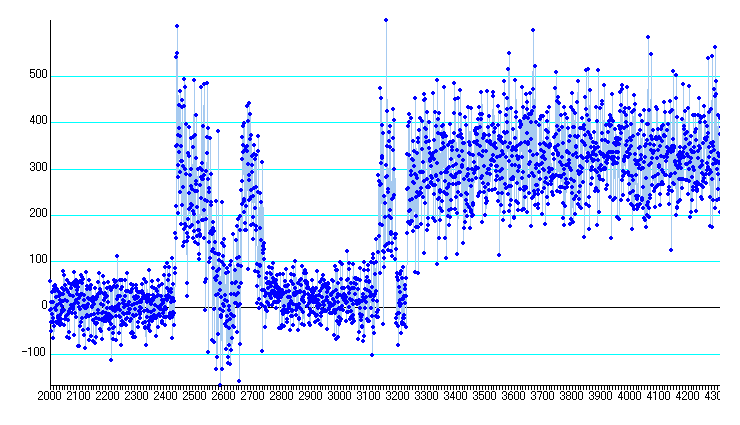
Corrected value, by compared with sunlit place
The luminous change became clear, and it looks easy to get the time of event.
Then, I started the experiment of diffraction fitting. See below.
Fig.5 The effect of the correction when absorption of light by cloud is large.
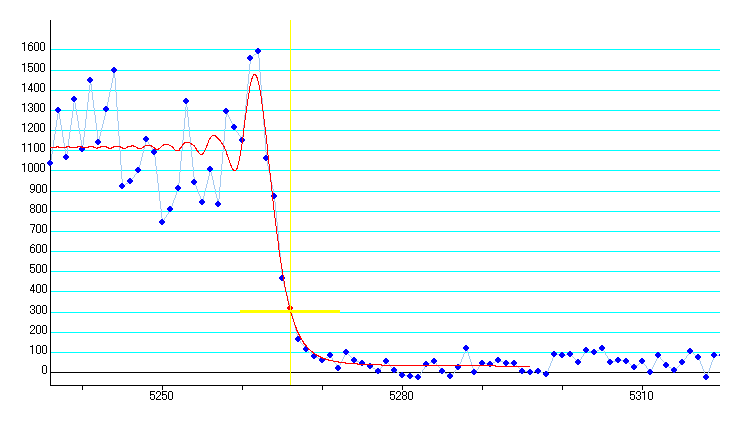
Observed by Hayamizu (DD2)
Time 19:02:27.06 (Center of Frame No.5266) + 1 millisecond (diffraction Fitting) [04]
Lunar Limb Angle = 83.5 (R=0.113)
Observed by Hayamizu (RD2)
Time 19:02:31.33 (Center of Frame No.5394) - 4 millisecond (diffraction Fitting) [31]
Lunar Limb Angle = 86.8 (R=0.055)
Fig.6 Fitting on diffraction simulation.
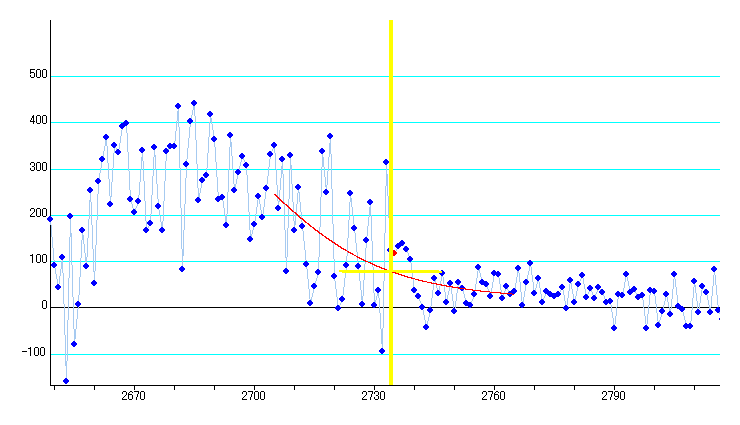
Observed by Saeki (RD1 )
Time 19:02:0.440 (Center of Frame No.2735) - 30 millisecond (diffraction Fitting) [01]
Lunar Limb Angle = 89.4 (R=0.010)
Observed by Saeki (RD1 )
Time 19:02:13.460 (Center of Frame No.3126) + 131 millisecond (diffraction Fitting) [01]
Lunar Limb Angle = 87.8 (R=0.039)
Note: It looks that it should be setting No.3131 frame as the 25% point. However, in this case,
Limovie obtained a incorrect result about luminous changing as 1.6 times faster than theoretical
value. It is thought that it's because the change in short wavelength, by the air scintillation,
influences to estimate process. This fitting was optimized by the trial and error with looking at
the chart.
Fig.7 The light curve obtained from data corrected by sunlit point and diffraction Fitting
Fig.8 Lunar profile obtaied from timming analysis and diffraction fitting.
End of this Report.
There are lightcurves of each event :
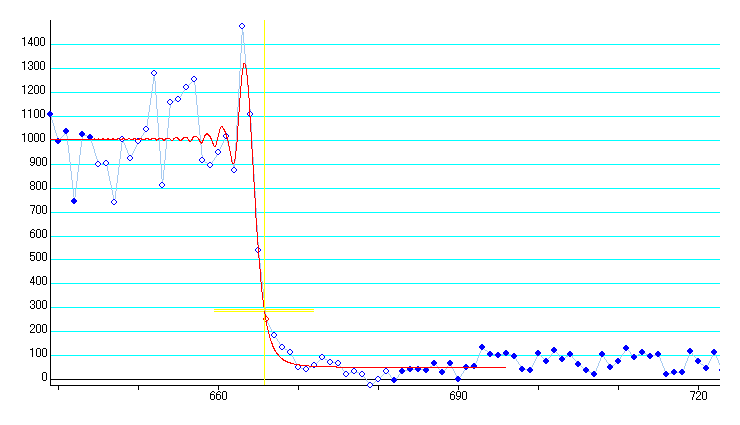
Observed by Hayamizu (DD1)
Time 18:53:59.57 (Center of Frame No.666) – 8 millisecond (diffraction Fitting)
Lunar Limb Angle = 78.3
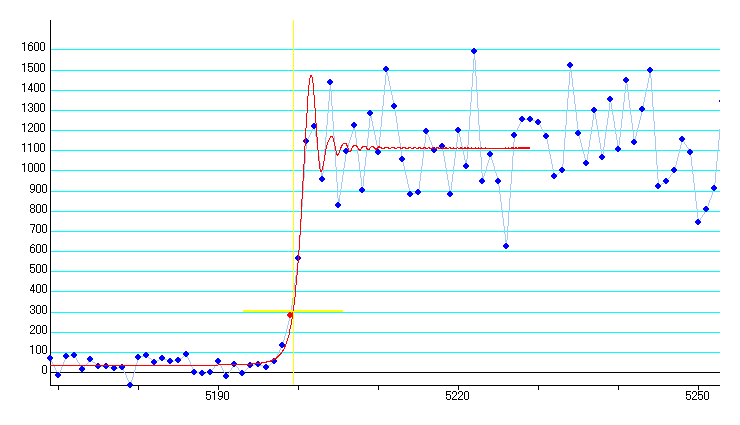
Observed by Hayamizu (RD1)
Time 19:02:24.82 (Center of Frame No.5199) + 11 millisecond (diffraction Fitting) [81]
Lunar Limb Angle = 76.9 (R=0.227)

Observed by Hayamizu (DD2)
Time 19:02:27.06 (Center of Frame No.5266) + 1 millisecond (diffraction Fitting) [04]
Lunar Limb Angle = 83.5 (R=0.113)
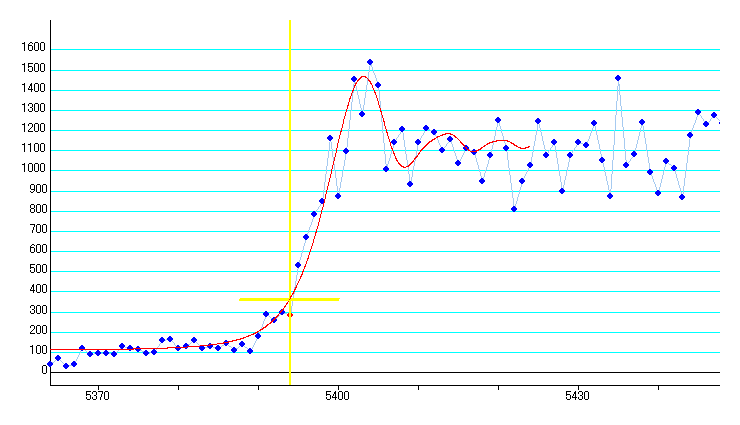
Observed by Hayamizu (RD2)
Time 19:02:31.33 (Center of Frame No.5394) - 4 millisecond (diffraction Fitting) [31]
Lunar Limb Angle = 86.8 (R=0.055)
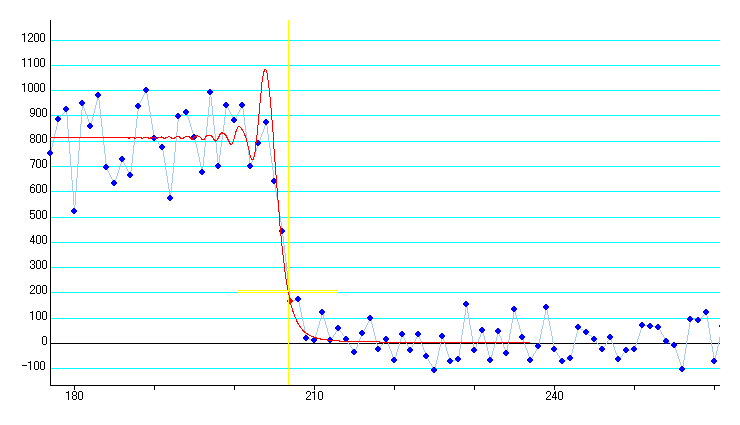
Observed by Maeda (DD1)
Time 19:01:07.21 (Center of Frame No.207) - 10 millisecond (diffraction Fitting) [20]
Lunar Limb Angle = 79.8 (R=0.177)
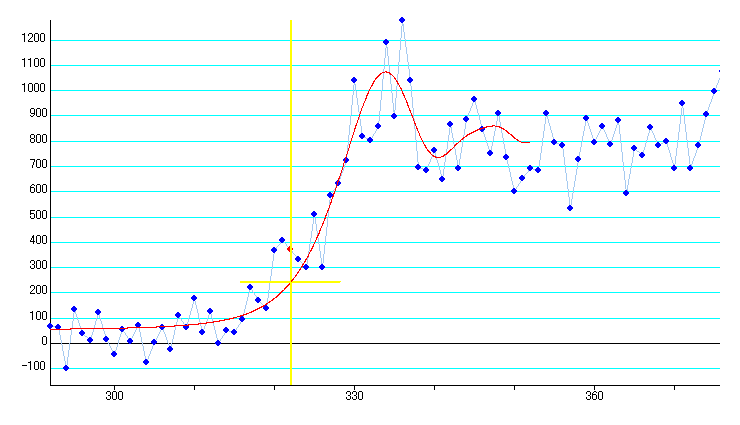
Observed by Maeda (RD1)
Time 19:01:11.07 (Center of Frame No.322) - 10 millisecond (diffraction Fitting) [05]
Lunar Limb Angle = 87.5 (R=0.043)
It may be double star's luminous change.

Observed by Maeda (DD2)
Time 19:01:14.39 (Center of Frame No.421) + 2 millisecond (diffraction Fitting) [37]
Lunar Limb Angle = 81.7 (R=0.144)

Observed by Maeda (RD2)
Time 19:01:47.24 (Center of Frame No.1400) + 8 millisecond (diffraction Fitting) [22]
Lunar Limb Angle = 80.2 (R=0.170)

Observed by Maeda (DD3)
Time 19:02:02.37 (Center of Frame No.1851) + 17 millisecond (diffraction Fitting) [36]
Lunar Limb Angle = 79.6 (R=0.181)
Average is fixed
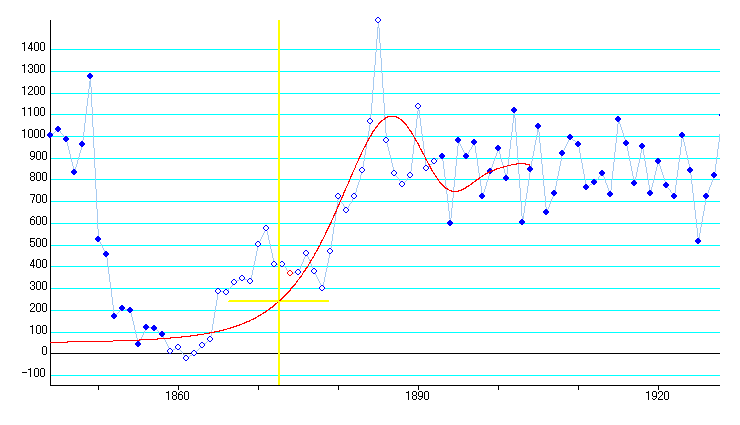
Observed by Maeda (RD3)
Time 19:02:03.15 (Center of Frame No.1874) - 47 millisecond (diffraction Fitting) [13]
Lunar Limb Angle =87.9 (R=0.036)
It will be luminous change of double star.

Observed by Maeda (RD3)
Re
Try by different setting.
Time 19:02:03.31 (Center of Frame No.1879) - 34 millisecond (diffraction Fitting) [30]
Lunar Limb Angle = 85.6 (R=0.077)
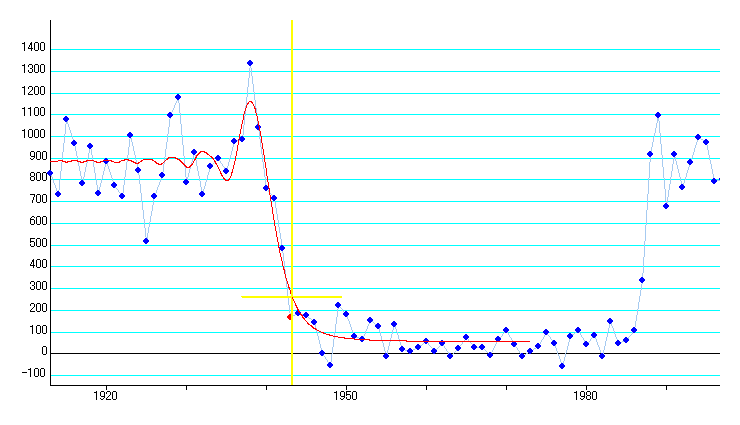
Observed by Maeda (DD4)
Time 19:02:05.46 (Center of Frame No.1943) + 7 millisecond (diffraction Fitting) [44]
Lunar Limb Angle = 84.4 (R=0.097)

Observed by Maeda (RD4)
Time 19:02:06.94 (Center of Frame No.1987) - 13 millisecond (diffraction Fitting) [92]
Lunar Limb Angle = 76.2 (R=0.239)
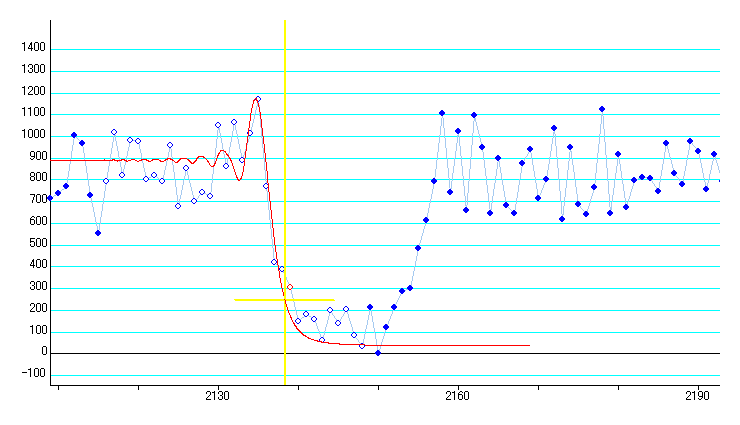
Observed by Maeda (DD5)
Time 19:01:.11.77 (Center of Frame No.2139) - 24 millisecond (diffraction Fitting) [75]
Lunar Limb Angle = 82.0 (R=0.139)
It will be luminous change by the occultation of double star.
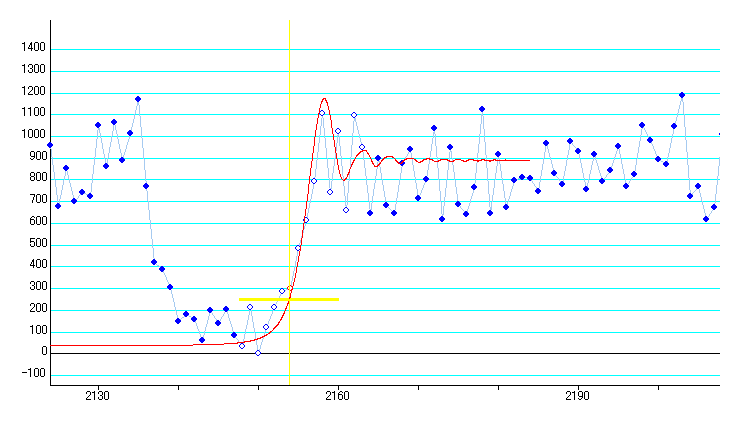
Observed by Maeda (RD5)
Time 19:02:12.54 (Center of Frame No.2154) - 5 millisecond (diffraction Fitting) [53]
Lunar Limb Angle = 83.3 (R=0.116)
It will be luminous change by the occultation of double star.
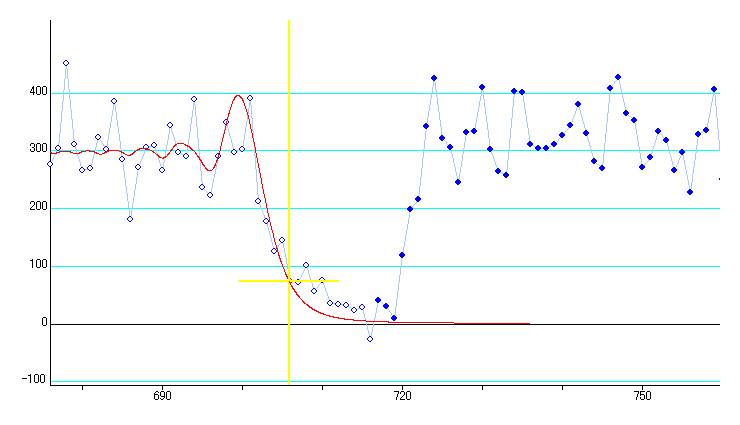
Observed by Kumamoto (DD1)
Time 19:00:25.30 (Center of Frame No.706) - 6 millisecond (diffraction Fitting) [29]
Lunar Limb Angle = 85.4 (R=0.080)
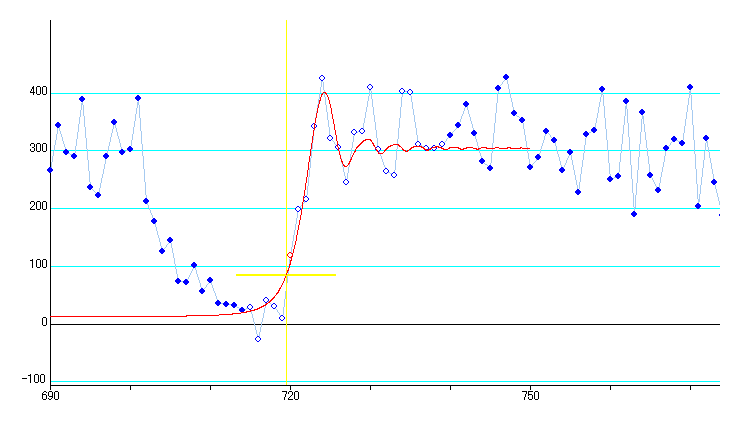
Observed by Kumamoto (RD1)
Time 19:00:25.77 (Center of Frame No.720) - 17 millisecond (diffraction Fitting) [75]
Lunar Limb Angle = 83.9 (R=0.107)

Observed by Kumamoto (DD2)
Time 19:00:38.28 (Center of Frame No.1094) - 17 millisecond (diffraction Fitting) [27]
Lunar Limb Angle = 79.0 (R=0.191)
It will be luminous change by the occultation of double star.
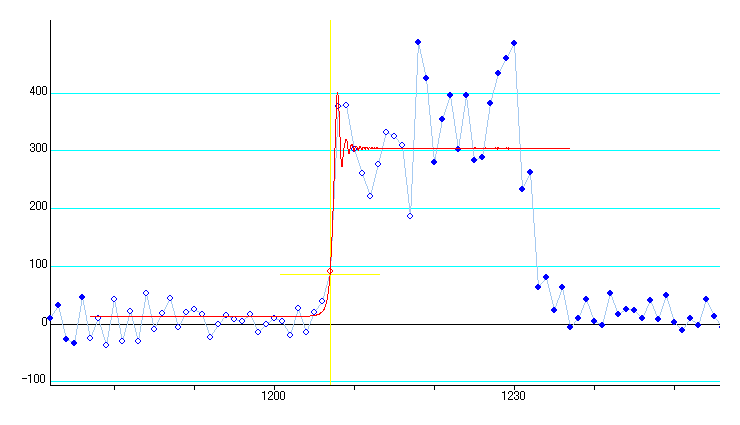
Observed by Kumamoto (RD2)
Time 19:00:42.07 (Center of Frame No.1207) - 2 millisecond (diffraction Fitting) [05]
Lunar Limb Angle = 57.7 (R=0.535)

Observed by Kumamoto (DD3)
Time 19:00:42.97 (Center of Frame No.1234) + 11 millisecond (diffraction Fitting) [95]
Lunar Limb Angle = 84.8 (R=0.090)
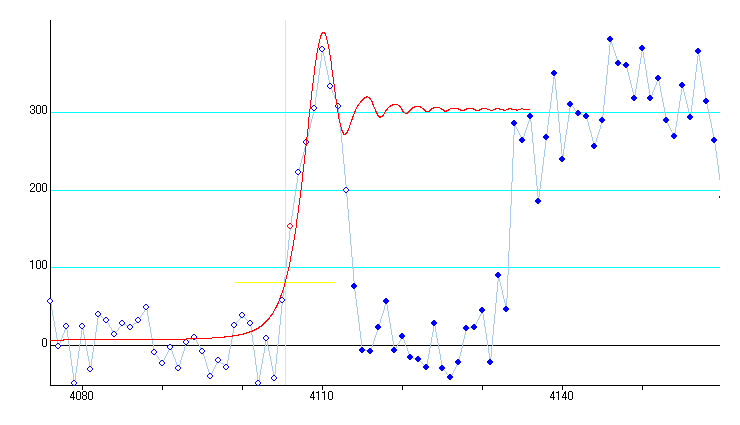
Observed by Kumamoto (RD3)
Time 19:02:19.13 (Center of Frame No.4106) - 23 millisecond (diffraction Fitting) [11]
Lunar Limb Angle = 83.9 (R=0.106)
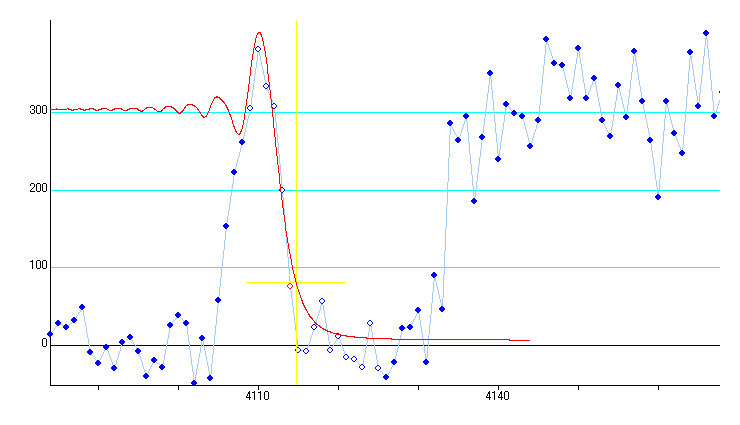
Observed by Kumamoto (DD4)
Time 19:02:19.40 (Center of Frame No.942) + 25 millisecond (diffraction Fitting) [12]
Lunar Limb Angle = 96.3 (R=-0.110) (83.7 R=0.110 ソフト改良の余地あり)
BKG Levelを4100frame以前から、Brightness を4140frame以降から取得

Observed by Kumamoto (RD4
)
Time 19:02:20.03 (Center of Frame No.4133) + 10 millisecond (diffraction Fitting) [01]
Lunar Limb Angle = 63.8 (R=0.441)

Observed by Saeki (DD1)
Time 19:01:0.599 (Center of Frame No.942) + 11 millisecond (diffraction Fitting) [01]
Lunar Limb Angle = 61.7 (R=0.414)
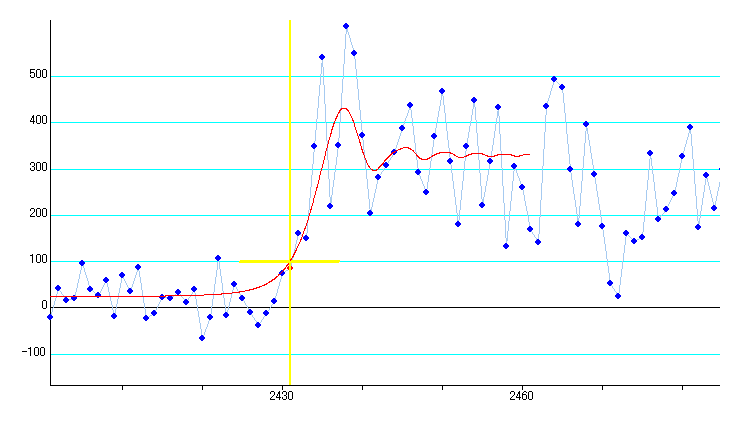
Observed by Saeki (RD1 )
Time 19:1:49.317 (Center of Frame No.2431) - 8 millisecond (diffraction Fitting) [01]
Lunar Limb Angle = 85.8 (R=0.074)
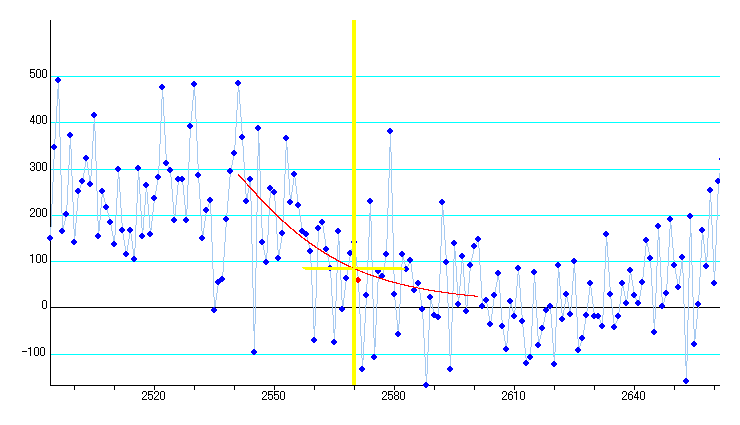
Observed by Saeki (DD2 )
Time 19:1:53.978 (Center of Frame No.2571) - 40 millisecond (diffraction Fitting) [01]
Lunar Limb Angle = 89.4 (R=0.001)
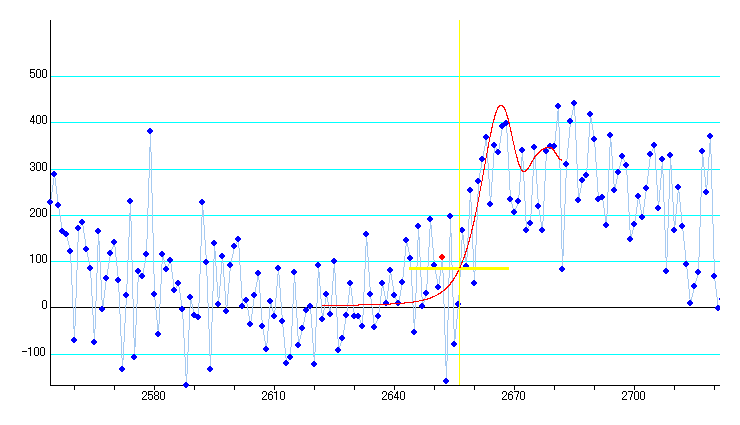
Observed by Saeki (RD2
)
Time 19:1:57.676 (Center of Frame No.2652) + 143 millisecond (diffraction Fitting) [01]
Lunar Limb Angle = 87.2 (R=0.049)
It will be luminous change by the occultation of double star.

Observed by Saeki (DD3
)
Time 19:02:0.440 (Center of Frame No.2735) - 30 millisecond (diffraction Fitting) [01]
Lunar Limb Angle = 89.4 (R=0.010)
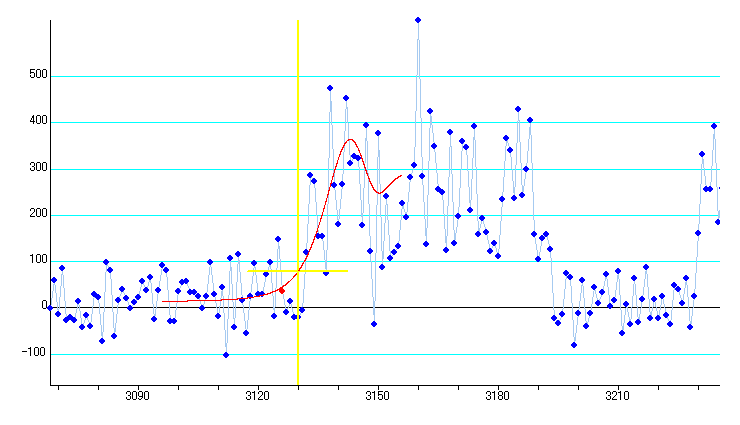
Observed by Saeki (RD3
)
Time 19:02:13.460 (Center of Frame No.3126) + 131 millisecond (diffraction Fitting) [01]
Lunar Limb Angle = 87.8 (R=0.039)
Note: It looks that it should be setting No.3131 frame as the 25% point. However, in this case,
Limovie obtained a incorrect result about luminous changing as 1.6 times faster than theoretical
value. It is thought that it's because the change in short wavelength, by the air scintillation,
influences to estimate process. This fitting was optimized by the trial and error with looking at
the chart.
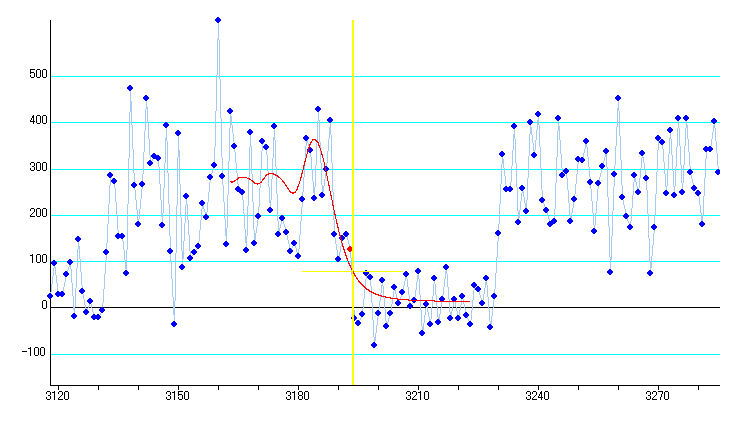
Observed by Saeki (RD1 )
Time 19:02:15.692 (Center of Frame No.3193) + 19 millisecond (diffraction Fitting) [01]
Lunar Limb Angle = 87.0 (R=0.053)

Observed by Saeki (RD1 )
Time 19:02:16.924 (Center of Frame No.3230) -16 millisecond (diffraction Fitting) [01]
Lunar Limb Angle = 67.0 (R=0.391)

Observed by Saeki (DD1)
Time 19:01:. (Center of Frame No.942) + 11 millisecond (diffraction Fitting) [31]
Lunar Limb Angle = . (R=0.)